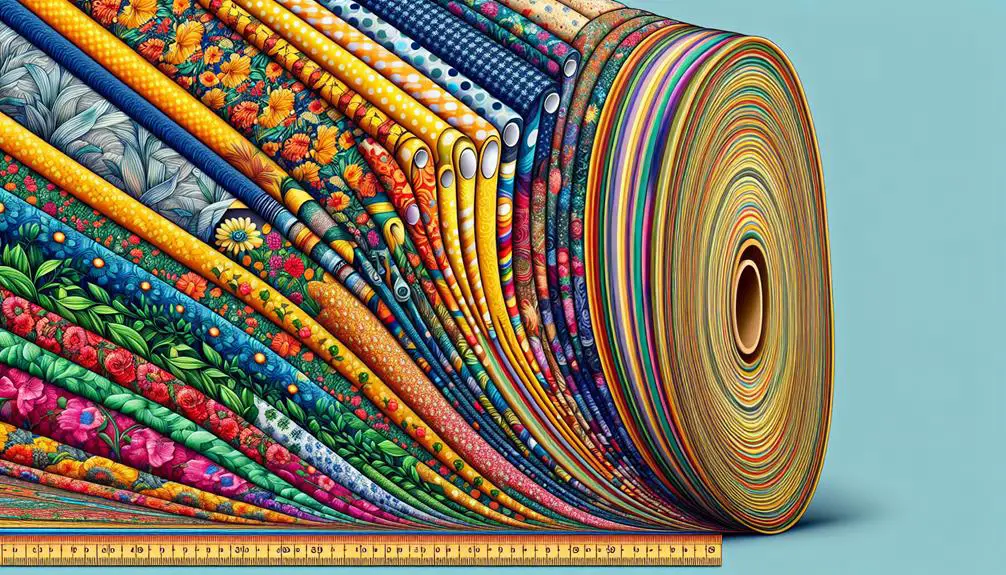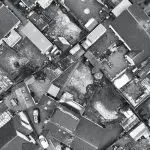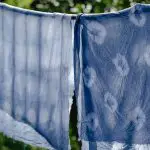Imagine a bolt of fabric as a long, winding road with a mysterious destination.
You might be wondering, how many yards can one actually find on such a bolt?
Well, the answer might surprise you.
Stay tuned to uncover the secrets behind the yardage of fabric bolts and how this knowledge can revolutionize your next project.
Table of Contents
Key Takeaways
- Fabric bolts contain varying yardage based on width, ranging from 8 to 15 yards.
- Understanding fabric widths helps determine the total yards on a bolt accurately.
- Calculating yardage is essential for sewing projects like curtains or dresses.
- Accurate estimation of fabric needed considers factors like weight, thickness, and weave.
Standard Yardage on Fabric Bolts
When I go to buy fabric, I always wonder how many yards are typically on a bolt. Fabric bolt sizes can vary, but a standard bolt usually contains around 15 yards of fabric. This amount is great for many projects, from clothing to home decor. If you need to convert this yardage into different units, there are simple yardage conversion formulas you can use.
Understanding fabric bolt sizes is essential, especially if you have a specific project in mind. Knowing that a standard bolt contains approximately 15 yards can help you estimate how much fabric to purchase. This estimate is handy when you're planning to make something like curtains or a dress that requires several yards of fabric.
Yardage conversion formulas come in handy when you need to convert fabric measurements from yards to other units like feet or meters. By knowing these formulas, you can accurately determine how much fabric you need for your project without any confusion.
Different Fabric Widths and Yardage
So, let's talk about the different fabric widths you might come across and how they affect yardage.
It's important to understand how width options can impact your project.
I'll also guide you on calculating yardage needs based on the fabric width and your project requirements.
Fabric Width Options
Different fabric widths impact the yardage needed for a project. When considering fabric width options, understanding how it affects the amount of fabric required is crucial. Here are a few key points to keep in mind:
- Fabric width considerations: Different fabrics come in various widths, such as 45 inches, 54 inches, and 60 inches. These widths determine how much fabric you need for your project.
- Yardage flexibility: Choosing the right fabric width can offer flexibility in adjusting the yardage required for a specific project, allowing for better customization.
- Fabric width impact: The width of the fabric directly impacts how you lay out and cut your pattern pieces, affecting the overall yardage needed for your sewing or crafting project.
Calculating Yardage Needs
To accurately calculate your yardage needs for a sewing or crafting project, consider the fabric width options available and how they impact the total amount of fabric required. Fabric yardage planning involves knowing the width of the fabric you plan to use, typically 36, 45, 54, or 60 inches wide.
When it comes to fabric yardage conversion, the wider the fabric, the less you generally need. For instance, if a project requires 3 yards of 45-inch wide fabric, you might only need 2 yards if the fabric is 60 inches wide.
Understanding these differences in fabric width options can help you optimize your fabric usage and avoid purchasing more than necessary for your projects.
Fabric Bolt Lengths
Considering the various fabric widths and yardage options available, it's important to understand how the length of fabric bolts differs based on the width you choose.
- Fabric bolt sizes: Fabric bolts typically come in varying widths, such as 45 inches, 54 inches, and 60 inches.
- Yardage variations: The yardage on a bolt can range from 8 yards to 15 yards or more, depending on the width of the fabric.
- Choosing the right width: Selecting the appropriate fabric width is essential to assure you have enough material for your project while minimizing waste.
Understanding fabric bolt sizes and yardage variations will help you make informed decisions when purchasing fabric for your sewing or crafting projects.
Calculating Yardage for Your Project
Alright, let's talk about calculating yardage for your sewing or crafting project.
When it comes to estimating how much fabric you need, a few key points can make the process a whole lot easier.
I'll share some yardage calculation tips and tricks to help you plan your project with confidence.
Yardage Calculation Tips
When calculating yardage for your project, it's important to measure accurately and consider any pattern repeats. To make sure you get the right amount of fabric, here are some yardage calculation tips:
- Yardage Conversion Techniques: Learn how to convert between different units of measurement to avoid running short on fabric.
- Maximizing Fabric Efficiency: Strategically plan your pattern layout to minimize waste and make the most out of your fabric.
- Fabric Bolt Yardage Variations: Understand that the yardage on fabric bolts can vary, so always double-check and account for any discrepancies.
These tips will help you estimate the required yardage more accurately, saving you time and money on your sewing projects.
Project Yardage Estimation
To accurately calculate the yardage needed for your project, start by determining the dimensions of each pattern piece and guaranteeing that you account for any pattern repeats. This step certifies you get the right amount of fabric without running short.
When estimating yardage, consider the fabric width and the layout of the pattern pieces to minimize waste. Fabric yardage hacks like nesting pattern pieces closer together can help you save on fabric and reduce costs.
Additionally, utilizing yardage saving strategies such as cutting pieces on the bias or using creative pattern placements can optimize the amount of fabric needed for your project. By carefully planning and calculating your yardage, you can efficiently manage your fabric and create beautiful pieces with minimal waste.
Understanding Fabric Measurements
Understanding fabric measurements can sometimes be confusing, but it's essential for choosing the right amount of material for your projects. When dealing with fabric, it's critical to grasp the basics of fabric roll sizes and yardage conversions to make sure you get the correct amount of fabric for your sewing endeavors.
- Fabric Roll Sizes: Fabric typically comes in rolls or bolts, which are usually around 40 to 42 inches wide. Understanding the standard widths of fabric rolls can help you estimate how much fabric you need for your project accurately.
- Yardage Conversions: Familiarizing yourself with yardage conversions is key to converting between different units of measurement. For instance, knowing that 1 yard is equal to 3 feet can be handy when working on projects that require measurements in feet rather than yards.
- Measuring Techniques: Learning the proper way to measure fabric can prevent errors in estimating yardage. Knowing how to lay out fabric correctly and measure it accurately can save you from running short on material mid-project.
Factors Affecting Yardage on a Bolt
Fabric rolls can vary in yardage due to factors such as the fabric weight, thickness, and weave. When it comes to yardage on a bolt, two important factors to take into account are fabric shrinkage and pattern complexity.
Fabric shrinkage plays a significant role in determining the final yardage you have available for your project. Some fabrics are prone to shrinking when washed or dried, which can impact the usable yardage on a bolt. It's essential to factor in potential shrinkage when calculating the amount of fabric needed for your project to avoid running short.
Pattern complexity is another factor that can impact the yardage required. Intricate patterns or designs may require more fabric to make sure proper alignment and pattern matching. When working with complex patterns, it's advisable to purchase extra yardage to accommodate any unforeseen adjustments or pattern matching intricacies.
Taking into account these factors along with the fabric weight, thickness, and weave will help you accurately determine the yardage needed for your sewing projects.
Buying Fabric by the Bolt
When purchasing a bolt of fabric, it's important to contemplate the quantity and quality you need for your sewing projects. Buying in bulk can be beneficial as it often comes with discounts, making it a cost-effective option for avid sewers. Additionally, storing fabric bolts properly is important to maintain their quality and prevent damage over time.
- Bulk Discounts: Purchasing fabric by the bolt can lead to significant savings due to bulk discounts offered by many fabric stores.
- Quality Consideration: Make sure the fabric you choose meets your project requirements regarding texture, weight, and color before buying in bulk.
- Fabric Storage: Properly storing fabric bolts in a cool, dry place away from direct sunlight and moisture can help preserve their quality for future use.
Converting Yardage to Other Units
When deciding to utilize fabric from a bolt for sewing projects, it's helpful to know how to convert yardage to other units for accurate measurements. Understanding yardage conversions is crucial, especially when working with sewing patterns that may require measurements in different units.
In the crafting world, fabric bolt yardage is typically measured in yards, but there are instances where you might need to convert this yardage to other units like meters, feet, or inches. For instance, if a pattern you're following provides measurements in meters, knowing how to convert from yards can save you time and avoid any errors in your project.
Converting yardage to the metric system involves some basic calculations. For example, one yard is approximately equal to 0.9144 meters. So, if you have 3 yards of fabric, it would be about 2.7432 meters. Being able to convert fabric measurements accurately will guarantee that your crafting projects turn out just the way you envision them.
Estimating Yardage in Sewing Patterns
Estimating yardage in sewing patterns requires careful consideration of the fabric requirements for your project. When determining fabric consumption for your sewing project, there are essential factors to keep in mind:
- Pattern Layout: Examining the layout of pattern pieces on the fabric can help optimize yardage usage. By strategically placing pattern pieces, you can minimize waste and potentially reduce the overall yardage needed.
- Extra Fabric: It's advisable to purchase slightly more fabric than the pattern suggests to account for any errors or alterations during the sewing process. Having a buffer of extra fabric guarantees that you don't run short in case of mistakes.
- Fabric Width: Understanding the width of the fabric you plan to use is critical for accurate yardage estimates. Wider fabrics typically require less yardage compared to narrower ones for the same pattern.
Maximizing Yardage Efficiency
To maximize yardage efficiency in your sewing projects, consider strategic placement of pattern pieces on the fabric to minimize waste. Fabric wastage reduction is important when you want to get the most out of the material you have. Efficient cutting techniques play a significant role in achieving this goal.
One effective strategy is to lay out your pattern pieces close together, minimizing the space between them. This way, you can fit more pieces onto the fabric, reducing unused areas. Additionally, rotating your pattern pieces at different angles can help optimize the use of fabric.
When cutting out your pieces, pay attention to the layout suggested in the pattern instructions. Following these guidelines can often lead to better fabric utilization. Using cutting techniques like 'cut on the fold' or 'cut selvage to selvage' can further enhance your efficiency.
Frequently Asked Questions
Can I Request a Specific Fabric Design or Pattern When Buying Fabric by the Bolt?
When buying fabric by the bolt, requesting custom designs or patterns is possible. However, it may impact pricing considerations. Bulk purchasing allows for negotiating preferences. Remember, customizations may influence the cost per yard.
Are There Any Special Considerations When Estimating Yardage for Sewing Patterns With Intricate Details or Multiple Layers?
When estimating yardage for intricate patterns, I always account for seam allowance and pattern matching. It secures a precise fit and cohesive design. Taking time for these considerations can elevate the final piece immensely.
How Do Factors Like Fabric Stretchiness or Shrinkage Affect the Yardage Needed for a Project?
Fabric texture and drape impact yardage needs for sewing projects. Stretchy fabrics require more yardage for pattern matching. Shrinkage can affect final dimensions, necessitating extra fabric. Consider these factors when estimating yardage for a project.
Are There Any Tips for Maximizing Yardage Efficiency When Working With Limited Fabric?
When working with limited fabric, I maximize yardage efficiency by creatively placing patterns and utilizing fabric scraps. This approach guarantees minimal waste and allows me to complete projects with precise measurements and resourcefulness.
What Are Some Common Mistakes to Avoid When Converting Yardage to Other Units for International Projects?
When converting yardage for international projects, common pitfalls include overlooking metric system nuances and miscalculating. To avoid errors, double-check conversions, use reliable conversion charts, and stay mindful of unit differences.
- Recycling Nonwoven Fabrics: Is It Possible? - July 11, 2025
- Recycling Nonwoven Fabrics: Is It Possible? - July 11, 2025
- Recycling Nonwoven Fabrics: Is It Possible? - July 11, 2025






